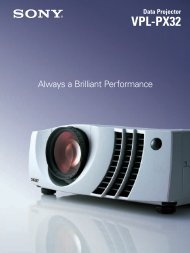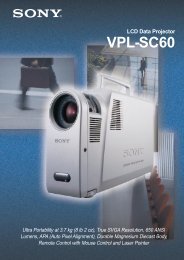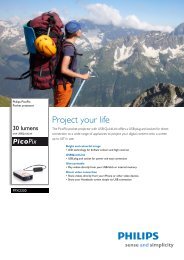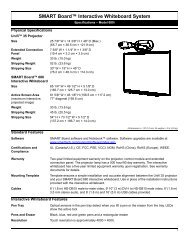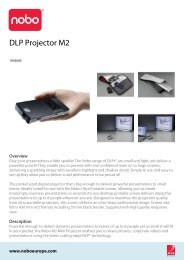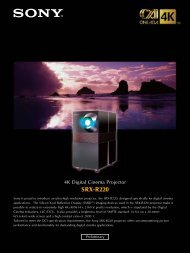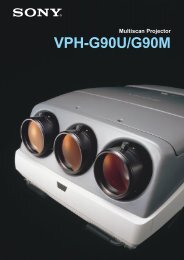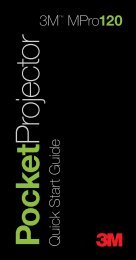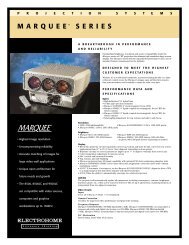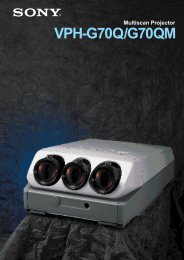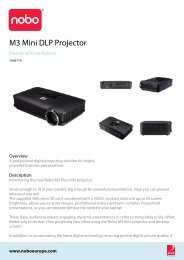DILA Tech Guide.qxd - BigScreen.se
DILA Tech Guide.qxd - BigScreen.se
DILA Tech Guide.qxd - BigScreen.se
You also want an ePaper? Increase the reach of your titles
YUMPU automatically turns print PDFs into web optimized ePapers that Google loves.
1.0<br />
Figure: Light Source Spectrum Characteristic<br />
Relative<br />
strength<br />
Natural daylight<br />
Metal halide<br />
Xenon<br />
Ultra-high-pressure<br />
mercury<br />
illumination system.<br />
The integrator (<strong>se</strong>e below) is frequently u<strong>se</strong>d in combination<br />
with polarization conversion elements (primarily with D-ILA TM<br />
and LCD projectors which u<strong>se</strong> polarization conversion),while<br />
the light pipe is u<strong>se</strong>d with DLP TM projectors (which u<strong>se</strong> natural<br />
light).<br />
0.8<br />
Figure: Light Pipe Concept Diagram<br />
0.6<br />
0.4<br />
Light B<br />
Light Pipe<br />
0.2<br />
Light A<br />
0<br />
400<br />
500 600 700 800<br />
Wavelength[nm]<br />
Light C<br />
In general, Xenon lamps are u<strong>se</strong>d for high light output and high<br />
color performance, UHP lamps for low price and compact size,<br />
and MH lamps for applications that fall somewhere in between.<br />
However, as performance of the lamps them<strong>se</strong>lves is improving<br />
it is possible that projector performance will be revolutionized in<br />
the near future by even higher brightness points (point light<br />
sources), higher efficiency, and higher color performance.<br />
Lamps are one of the most critical components of projectors.<br />
Figure: Integrator Diagonal View Concept Diagram<br />
Outgoing<br />
surface<br />
D-ILA<br />
Illumination optical system<br />
➀ Uniform illumination<br />
Various improvements allow more effective and uniform illumination<br />
of the projection device with the light from the lamp. In<br />
addition to optimization of reflectors and light collecting len<strong>se</strong>s,<br />
light pipes and integrators made up of fly eye len<strong>se</strong>s have been<br />
u<strong>se</strong>d for dramatic performance improvements.<br />
Incoming<br />
surface<br />
Fly eye 2<br />
As the figure shows, a light pipe is a square pillar that repeatedly<br />
and completely reflects incoming light on its glass surfaces.<br />
This converts the light flux distribution that is non-uniform,<br />
at the incoming surface, into a uniform light flux distribution<br />
at the pipe outgoing surface. At the same time, the light<br />
utilization efficiency is improved through efficient conversion<br />
that matches the light pipe outlet surface shape to the shape<br />
of the surface to be illuminated.<br />
Fly eye 1<br />
Figure: Integrator Sectional Diagram<br />
FEP1 FEP2 Field lens<br />
Lamp<br />
Projection<br />
device<br />
As the figure shows, an integrator compri<strong>se</strong>s two fly eye plates<br />
(FEP) of micro len<strong>se</strong>s.<br />
The light coming from the lamp via the reflector is input to<br />
FEP1. The images on each of the micro len<strong>se</strong>s pass through<br />
the micro-len<strong>se</strong>s of FEP2 and are projected onto the projection<br />
device. In other words, the light source image of one lamp is<br />
split as many ways as the number of micro len<strong>se</strong>s on FEP1 to<br />
improve the equivalent uniformity. Also, the integrator converts<br />
the light to a shape similar to the shape of the projection<br />
device and thus improves the light utilization efficiency of the<br />
12



